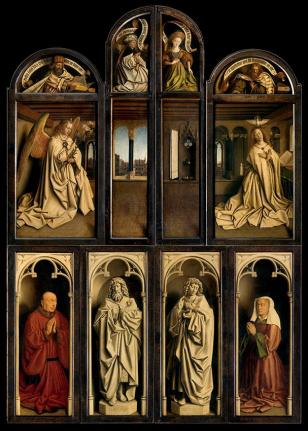This archived website 'Flemish primitives' is temporarily not being updated. Certain functionality (e.g. specific searches in the collection) may no longer be available. News updates about the Flemish primitives will appear on vlaamsekunstcollectie.be. Questions about this website? Please contact us at info@vlaamsekunstcollectie.be.
The restored exterior panels of the Ghent Altarpiece presented

Brothers Van Eyck, Ghent Altarpiece (closed, after restoration), 1432, Sint-Baafskathedraal Gent © www.lukasweb.be - Art in Flanders vzw.
After a conservation and restoration campaign of 4 years, dedicated to the exterior panels of the Ghent Altarpiece (1432) by the Brothers Van Eyck, the panels have been brought back to the Doopkapel in St Bavo's Cathedral in Ghent. The restoration campaign was under the guidance of the Royal Institute for Cultural Heritage (KIK, Brussels) and produced spectacular results. The restoration was subsidised by the Province of Flanders (Immovable Heritage) and the Flemish Community (Arts and Heritage).
In October 2012, the restoration campaign began in a specially equipped studio in the Museum of Fine Arts in Ghent (MSK). By way of a glass wall, the public could follow the progress. The interior panels of the Ghent Altarpiece remained in place in the St Bavo Cathedral. In the Caermersklooster, the exhibition Restauratie/REVELATIE (Restoration/REVELATION): The exterior panels of the Ghent Altarpiece is currently on display, which reveals the work from the previous 4 years.
Restoration
The restorers of the KIK removed heavily yellowed, synthetic varnish layers in a first stage. The varnish was a result of the last restoration in 1951. Underneath there appeared to be older oil and resin varnishes present. It was decided to remove these as well. The goal was a homogenous end result, by which each panel would receive the same treatment and the original condition would be brought back. In this way the aesthetic qualities of the Van Eycks' painting would be brought to life and the original painted layer could be enhanced.
However, aesthetic imperfections came to light that were not congruous with the technique of the Van Eycks. Further scientific research by the universities of Ghent and Antwerp confirmed the findings. Moreover, it seemed that circa 70% of the original painting surface was painted over. This involved overpaintings that dated from the 16th or early 17th centuries. From the technical research by the University of Antwerp and the University of Ghent, it appeared that the overpainting could be removed without damaging the original painting. An international committee of experts determined that a return to the original was a must.
After the patient removal with a scalpel and stereoscopic microscope, the well-preserved original layers of painting were conserved; lacunae were filled in; zones were retouched (retouches that later, if necessary, can be removed) and thin layers of varnish were applied.
Originally the KIK team were to provide only a limited conservation treatment to the frames, but after research it appeared that the original imitation stone was better preserved than previously surmised. As such, it was decided, fortified by the authorisation of the international committee of experts, to extensively restore all of the frames. Jan van Eyck painted his frames, making them an integral part of his paintings.
The new discoveries meant that the restoration would take quite a bit longer than planned and that extra financial means needed to be secured. That advanced insight and expertise of the KIK also ensured that the Ghent Altarpiece returns to a very good condition. In addition, it has become much stronger in an aesthetic and iconographic aspect than before. For all this time we have looked at this masterpiece of western painting through a distorted filter. Today, we see the original work of the Brothers Van Eyck again.
New restoration campaign
At this time the lower register of the interior panels, with the panel The Adoration of the Mystic Lamb, is present in the open studio in the MSK. For this second restoration campaign, 2 years is foreseen. In a third and last campaign the upper register is up for restoration. Here too are 2 years set aside. It is the question, however, as to what will be found under the heavily yellowed varnish on these panels. Also here a substantial number of old overpaintings might be discovered, so that a timing of 4 years-the time needed to restore the exterior panels-seems to be highly optimistic. The Minister of Culture Sven Gatz says with regards to this: ‘In the event that from further research by the restorers that it would appear that additional restoration works are necessary, than I shall seek a solution for this with the Flemish government.'
The St Bavo Cathedral and the Van Eyck exhibition
Flemish Minister of Tourism Ben Weyts is investing 4,3 million euro for a new visitors' centre and a closed visitor route in the St Bavo Cathedral as well as an extra entrance on the side of the cathedral. In the meantime, the conservation conditions are being investigated in the glass cage in which the multi-panelled work is stored. Years of poor conservation conditions have indeed led to this restoration campaign. The on-going research receives the support of the Panel and Paintings Initiative of the Getty Foundation (Los Angeles), among other sources.
Minister Weyts is setting aside 2,1 million within his initiative projects for an exhibition of Van Eyck that would take place in 2020 in the MSK. With the completion of the restoration campaign, the MSK wishes to dedicate an exhibition to Jan van Eyck and the court of the Burgundian dukes. It is unique that the exterior panels of the Ghent Altarpiece would come back to the MSK and engage in a dialog with other works by Van Eyck and his contemporaries.
(News item October 14, 2016)







